| Autore |
 Discussione Discussione  |
|
enrirubio
Utente V.I.P.
  
Città: Avilés
Regione: Spain

132 Messaggi
Micologia |
 Inserito il - 04 gennaio 2016 : 13:24:26 Inserito il - 04 gennaio 2016 : 13:24:26


|
Hi my friends
I need again your help for to try the determinatation of this fungus that forms small, more or less orbicular patches up to 30 x 8 mm on dead, still attached twigs of Quercus petraea at the sea level at the Botanical Garden of Gijón at the north of Spain.
The regular, roundish pores, 2-3 by mm have a withish fimbriate margin made by conspicually branched cylindrical hyaline hyphae. The relative big basidia seem to be 4-spored. Hyphal system dimitic with hyaline, thin-walled, 2-3 microns in diam., SIMPLE SEPTATE hyphae and tortuose, branched, hyaline, 1.5-2 microns in diam., slightly thick-walled, inamyloid binding hyphae. Basidiospores not amyloid, cylindrical-ellipsoid, 13-16 x 5-6 microns.
I fell this foungus could to belong to the genus Dichomitus but I don't know any species that fits well with this collection.
Have you some idea?
Many thanks again for you kindly help.
Immagine:

188,06 KB
Immagine:
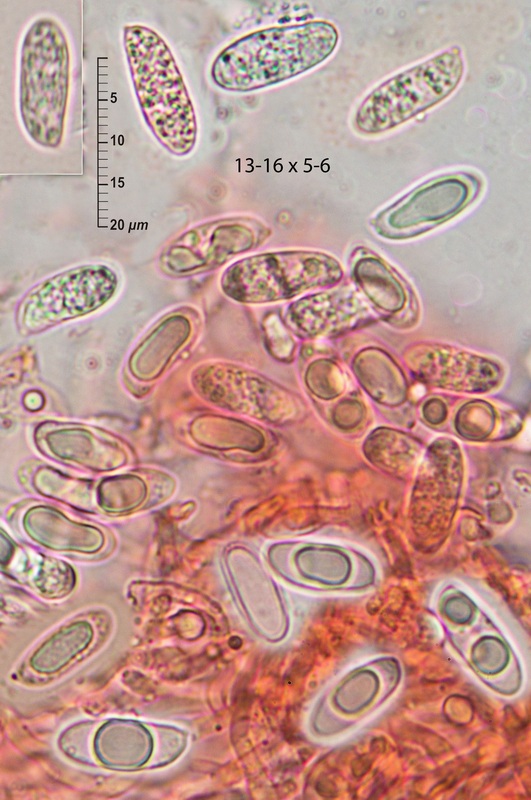
153,78 KB
|
Modificato da - Aphyllo in Data 11 marzo 2016 21:38:28
|
|
|
enrirubio
Utente V.I.P.
  
Città: Avilés
Regione: Spain

132 Messaggi
Micologia |
 Inserito il - 04 gennaio 2016 : 13:25:17 Inserito il - 04 gennaio 2016 : 13:25:17


|
Immagine:

188,06 KB
Immagine:

188,07 KB
Immagine:
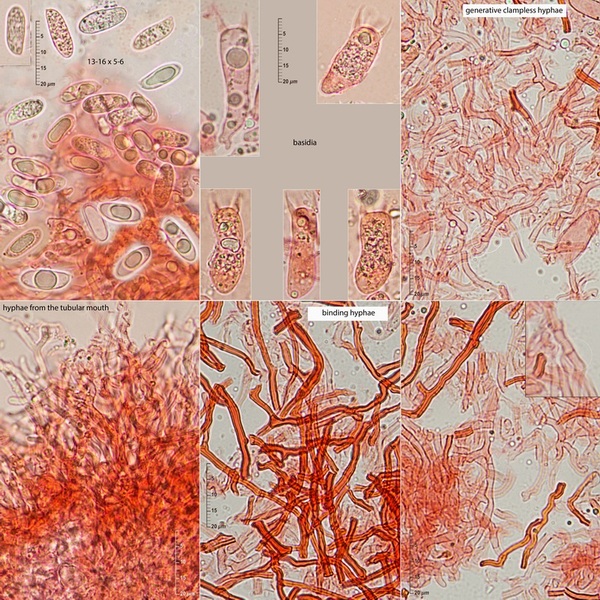
227,82 KB
Immagine:

188,06 KB |
|
Modificato da - enrirubio in data 04 gennaio 2016 13:34:13 |
 |
|
|
enrirubio
Utente V.I.P.
  
Città: Avilés
Regione: Spain

132 Messaggi
Micologia |
 Inserito il - 04 gennaio 2016 : 13:30:20 Inserito il - 04 gennaio 2016 : 13:30:20


|
macro
Immagine:

188,06 KB
Immagine:

188,07 KB |
|
Modificato da - enrirubio in data 04 gennaio 2016 13:33:18 |
 |
|
|
enrirubio
Utente V.I.P.
  
Città: Avilés
Regione: Spain

132 Messaggi
Micologia |
 Inserito il - 04 gennaio 2016 : 13:36:55 Inserito il - 04 gennaio 2016 : 13:36:55


|
Immagine:
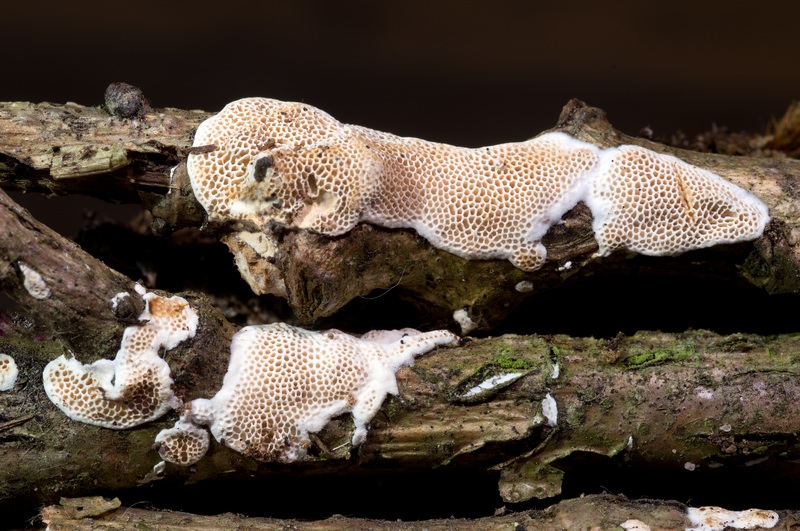
188,06 KB |
|
Modificato da - enrirubio in data 04 gennaio 2016 13:38:45 |
 |
|
|
enrirubio
Utente V.I.P.
  
Città: Avilés
Regione: Spain

132 Messaggi
Micologia |
 Inserito il - 04 gennaio 2016 : 17:27:28 Inserito il - 04 gennaio 2016 : 17:27:28


|
Immagine:
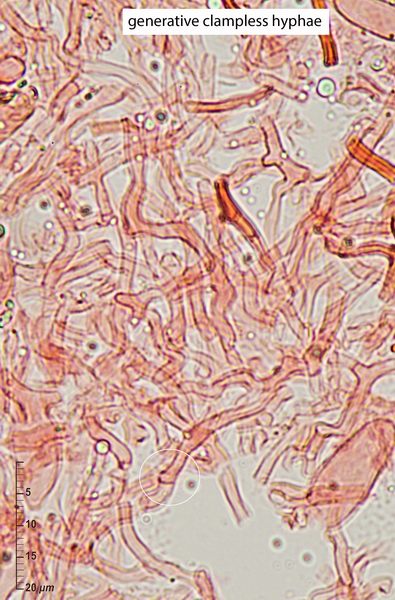
272,87 KB |
|
 |
|
|
enrirubio
Utente V.I.P.
  
Città: Avilés
Regione: Spain

132 Messaggi
Micologia |
 Inserito il - 04 gennaio 2016 : 17:29:13 Inserito il - 04 gennaio 2016 : 17:29:13


|
Immagine:
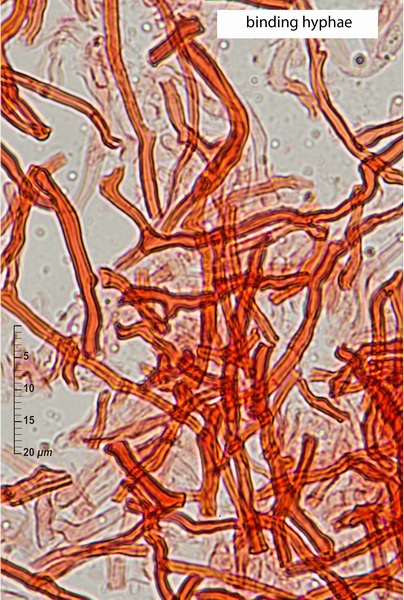
151,79 KB |
|
 |
|
|
enrirubio
Utente V.I.P.
  
Città: Avilés
Regione: Spain

132 Messaggi
Micologia |
 Inserito il - 04 gennaio 2016 : 17:31:38 Inserito il - 04 gennaio 2016 : 17:31:38


|
Immagine:
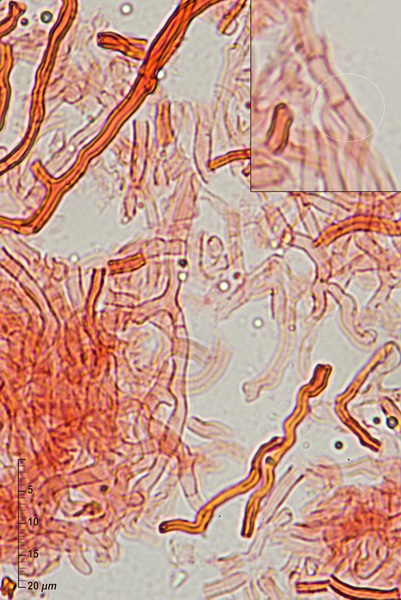
125,54 KB
More generative clampless hyphae |
|
 |
|
|
Fomes
Moderatore
    
Città: Prov. Milano

5273 Messaggi
Tutti i Forum |
 Inserito il - 04 gennaio 2016 : 18:07:18 Inserito il - 04 gennaio 2016 : 18:07:18


|
ciao,
e se appartenesse al genere Antrodia?
Magari una specie con crescita resupinata...poi le dimensioni delle spore sono notevoli...
La superficie poroide tende ad imbrunire? si intravedono delle macchie scure...

Renato |
|
 |
|
|
enrirubio
Utente V.I.P.
  
Città: Avilés
Regione: Spain

132 Messaggi
Micologia |
 Inserito il - 04 gennaio 2016 : 18:28:56 Inserito il - 04 gennaio 2016 : 18:28:56


|
Hi Fomes
I have considerated Antrodia but the lack of clamp conections seems to reject this genus, isn't?
The pore surface darks a little but it doesn't turn blackish
Thanks! |
|
 |
|
|
enrirubio
Utente V.I.P.
  
Città: Avilés
Regione: Spain

132 Messaggi
Micologia |
 Inserito il - 04 gennaio 2016 : 18:34:18 Inserito il - 04 gennaio 2016 : 18:34:18


|
I'm sorry. I wanted to say lack of skeletal hyphae, not of clamps connection.
Excuse me |
|
 |
|
|
Aphyllo
Moderatore
    
Città: firenze
Prov.: Firenze
Regione: Toscana

9113 Messaggi
Micologia |
 Inserito il - 04 gennaio 2016 : 21:55:01 Inserito il - 04 gennaio 2016 : 21:55:01


|
Ciao! complimenti per l'analisi microscopica!
Secondo me Fomes ha visto giusto! Sono quasi sicuro che quelle che hai scambiato per le ife generative senza giunti a f. in realtà sono ife di un fungo imperfetto un po' invadente. Ti invito a valutare l'ipotesi che si possa trattare di Antrodia albida o un'altra tra le Antrodia con grandi spore.
Antrodia albida in effetti ha una grande variabilità nella misura delle spore tanto che da molti micologi è considerato più un "complex" che una specie ben delimitata |
 |
|
|
enrirubio
Utente V.I.P.
  
Città: Avilés
Regione: Spain

132 Messaggi
Micologia |
 Inserito il - 05 gennaio 2016 : 00:21:16 Inserito il - 05 gennaio 2016 : 00:21:16


|
Ciao Aphyllo
The fruitbodys are young, fresh and in a good condition, so the hypothesis of a contamination by an hyphomycete is not very probable. By the other hand, how do you explain the lack of skeletal hyphae in the context? I think the fungus has only binding hyphae dichotomously branched as in Dichomitus species. |
|
Modificato da - enrirubio in data 05 gennaio 2016 00:42:01 |
 |
|
|
Gérard 57
Moderatore
   
Città: Neufchef
Prov.: Estero
Regione: France

1180 Messaggi
Micologia |
 Inserito il - 05 gennaio 2016 : 12:47:58 Inserito il - 05 gennaio 2016 : 12:47:58


|
Quant à moi, je partage le dernier point de vue de notre ami sur la fraîcheur et l'intégrité de son spécimen: tous les éléments présentés ici semblent appartenir au même champignon.
Toutefois, et malgré un certain flou des images sur ce plan, l'absence de boucles ne me paraît pas du tout certaine; d'ailleurs l'une des basides comporte apparemment une cloison basale bouclée. Il serait bon de revoir cette question en dilacérant bien le prélèvement sous la loupe avec deux aiguilles afin de dissocier les tissus.
A priori, je pense qu'on peut rapporter cette récolte à une espèce de la nébuleuse de taxons qui gravitent autour d'Antrodia albida, par exemple A. macrospora de notre amie Annarosa.
En tout cas, bravo pour cette magnifique photo de votre spécimen, Enrique! Il serait bien dommage qu'il tombe dans l'anonymat...
Gérard TRICHIES |
|
 |
|
|
enrirubio
Utente V.I.P.
  
Città: Avilés
Regione: Spain

132 Messaggi
Micologia |
 Inserito il - 05 gennaio 2016 : 14:24:05 Inserito il - 05 gennaio 2016 : 14:24:05


|
Bonsoir Gerard
Merci par ton aimable opinion. Ton apreciation sur le crochet basal d'un basidium est bien admirable, mais je pense qu'il un crochet abortive que n'a fait pas tout son developpement. Je vais tenter une fois plus l'etude des anses sur les hyphes mais je remarque que je n'ai vu pas nulle part des hyphes esqueletiques.
Avec toutes mes amitiés
Enrique |
|
 |
|
|
Aphyllo
Moderatore
    
Città: firenze
Prov.: Firenze
Regione: Toscana

9113 Messaggi
Micologia |
 Inserito il - 05 gennaio 2016 : 23:38:24 Inserito il - 05 gennaio 2016 : 23:38:24


|
Caro Enrique, questo è quello che ho trovato, e che non ho saputo interpretare, facendo la microscopia ad un' Antrodia albida. Contemèoraneamente ho trovato anche ife generative con evidenti giunti a fibbia
Immagine:
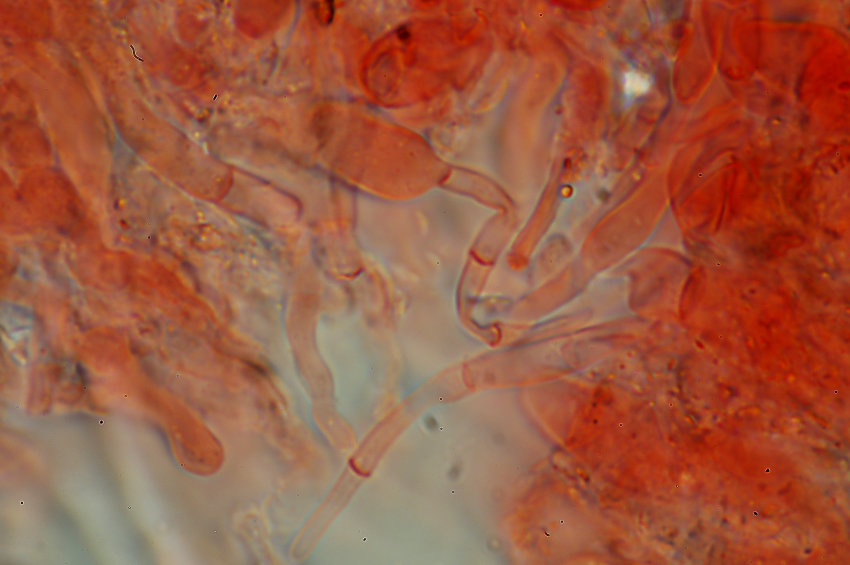
275,37 KB |
 |
|
|
enrirubio
Utente V.I.P.
  
Città: Avilés
Regione: Spain

132 Messaggi
Micologia |
 Inserito il - 06 gennaio 2016 : 12:15:04 Inserito il - 06 gennaio 2016 : 12:15:04


|
Ciao Aphyllo
Have you seen skeletal hyphae in your Antrodia? |
|
 |
|
|
Aphyllo
Moderatore
    
Città: firenze
Prov.: Firenze
Regione: Toscana

9113 Messaggi
Micologia |
 Inserito il - 06 gennaio 2016 : 14:09:46 Inserito il - 06 gennaio 2016 : 14:09:46


|
| Le ife strutturali sono presenti nella trama ma sono meno tortuose delle tue |
 |
|
|
enrirubio
Utente V.I.P.
  
Città: Avilés
Regione: Spain

132 Messaggi
Micologia |
 Inserito il - 06 gennaio 2016 : 14:32:08 Inserito il - 06 gennaio 2016 : 14:32:08


|
That is the question! If I could have seen skeletal hyphae I had no doubts my species belongs to the genus Antrodia...but that has clearly not been the case.
Thanks! |
|
 |
|
|
Aphyllo
Moderatore
    
Città: firenze
Prov.: Firenze
Regione: Toscana

9113 Messaggi
Micologia |
 Inserito il - 11 gennaio 2016 : 20:14:34 Inserito il - 11 gennaio 2016 : 20:14:34


|
| Ciao Enrique, ho preso in considerazione ancora una volta il tuo ritrovamento e devo dire che tutti gli elementi così come li hai presentati non conducono a nessuna specie descritta....se fossi in te darei di nuovo un'occhiata molto attenta al sistema ifale che potrebbe anche essere trimitico |
 |
|
|
enrirubio
Utente V.I.P.
  
Città: Avilés
Regione: Spain

132 Messaggi
Micologia |
 Inserito il - 11 gennaio 2016 : 20:25:26 Inserito il - 11 gennaio 2016 : 20:25:26


|
OK., Aphyllo. I will do again and again!
For exemple, now I'm studying a basidiome of Tyromyces chioneus on Larix but I did not saw any skeletal hyphae at the tubular trama and dissepiments, while a lot of litterature say thst this species has these structural hyphae! |
|
 |
|
|
Aphyllo
Moderatore
    
Città: firenze
Prov.: Firenze
Regione: Toscana

9113 Messaggi
Micologia |
 Inserito il - 11 gennaio 2016 : 21:46:14 Inserito il - 11 gennaio 2016 : 21:46:14


|
...in effetti in questa specie anche io ho trovato le strutturali solo nei dissepimenti e nella trama dei tubuli
Link |
 |
|
 Discussione Discussione  |
|

 Forum
|
Registrati
|
Msg attivi
|
Msg Recenti
|
Msg Pvt
|
Utenti
|
Galleria |
Map |
Forum
|
Registrati
|
Msg attivi
|
Msg Recenti
|
Msg Pvt
|
Utenti
|
Galleria |
Map |